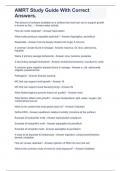How do molds replicate - Study guides, Class notes & Summaries
Looking for the best study guides, study notes and summaries about How do molds replicate? On this page you'll find 100 study documents about How do molds replicate.
All 100 results
Sort by
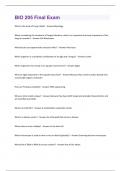 Popular
Popular
-
BIO 205 Final Exam Questions And Answers.
- Exam (elaborations) • 9 pages • 2024
- Available in package deal
-
- $7.19
- 1x sold
- + learn more
What is the study of Fungi called? - Answer-Mycology When considering the treatment of fungal infections, what is an important structural component of the fungi to consider? - Answer-Cell Membrane What tissues can opportunistic mycoses infect? - Answer-Any tissue Which organism is a symbiotic combination of an alga and a fungus? - Answer-Lichen Which organisms live mostly in an aquatic environment? - Answer-Algae Why are algae important in the aquatic food chain? - Answer-Because they conv...
AMRT Study Guide With Correct Answers.
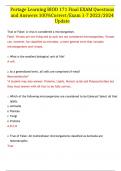
-
BIOD 171 Portage Learning Final EXAM Questions and Answers 100%Correct/Exam 1-7 2023/2024 Update
- Exam (elaborations) • 44 pages • 2023
-
- $20.99
- 5x sold
- + learn more
BIOD 171 Portage Learning Final EXAM Questions and Answers 100%Correct/Exam 1-7 2023/2024 UpdatePortage Learning BIOD 171 Final EXAM Questions and Answers 100%Correct/Exam 1-7 2023/2024 Update True or False: A virus is considered a microorganism. False. Viruses are not living and as such are not considered microorganisms. Viruses can, however, be classified as microbes, a more general term that includes microorganisms and viruses. 1. What is the smallest biological unit of life? A cell. ...

-
AMRT Study Guide Exam Review
- Exam (elaborations) • 13 pages • 2024
-
- $13.49
- + learn more
AMRT Study Guide Exam Review The amount of moisture available on a surface that mold can use to support growth is known as the... - ANS-water activity How do molds replicate? - ANS-Sporulation What molds produce respirable particles? - ANS-Aspergillus, penicillium Respirable - ANS-Can be deeply inhaled into lungs; 5 microns 4 common viruses found in sewage - ANS-rotavirus, GI virus, adenovirus, hepatitis Name 3 primary sewage biohazards - ANS-virus, bacteria, parasites 3 secondary sewage...
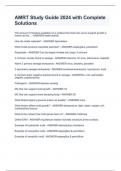
-
AMRT Study Guide 2024 with Complete Solutions
- Exam (elaborations) • 8 pages • 2024
-
Available in package deal
-
- $10.99
- + learn more
AMRT Study Guide 2024 with Complete SolutionsAMRT Study Guide 2024 with Complete SolutionsAMRT Study Guide 2024 with Complete SolutionsAMRT Study Guide 2024 with Complete Solutions The amount of moisture available on a surface that mold can use to support growth is known as the... - ANSWER-water activity How do molds replicate? - ANSWER-Sporulation What molds produce respirable particles? - ANSWER-Aspergillus, penicillium

-
AMRT Review Questions and Answers 100% Correct
- Exam (elaborations) • 8 pages • 2024
-
Available in package deal
-
- $10.99
- + learn more
AMRT Review Questions and Answers 100% Correct AMRT Review Questions and Answers 100% Correct AMRT Review Questions and Answers 100% Correct The amount of moisture available on a surface that mold can use to support growth is known as the? - ANSWER-Water Activity How do molds replicate? - ANSWER-Sporulation What molds produce respirable particles? - ANSWER-Aspergillus
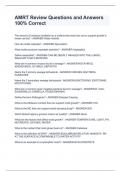
-
AMRT Review Questions and Answers 100% Correct
- Exam (elaborations) • 8 pages • 2024
-
Available in package deal
-
- $10.99
- + learn more
AMRT Review Questions and Answers 100% CorrectAMRT Review Questions and Answers 100% CorrectAMRT Review Questions and Answers 100% CorrectAMRT Review Questions and Answers 100% Correct The amount of moisture available on a surface that mold can use to support growth is known as the? - ANSWER-Water Activity How do molds replicate? - ANSWER-Sporulation What molds produce respirable particles? - ANSWER-Aspergillus
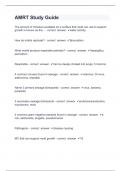
-
AMRT Study Guide Questions with complete solution
- Exam (elaborations) • 14 pages • 2024
-
Available in package deal
-
- $13.49
- + learn more
AMRT Study Guide Questions with complete solution AMRT Study Guide The amount of moisture available on a surface that mold can use to support growth is known as the... - correct answer water activity How do molds replicate? - correct answer Sporulation What molds produce respirable particles? - correct answer Aspergillus, penicillium Respirable - correct answer Can be deeply inhaled into lungs; 5 microns 4 common viruses found in sewage - correct answer rotavirus, GI vir...
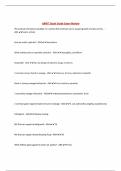
-
AMRT Study Guide Exam Review
- Exam (elaborations) • 13 pages • 2024
- Available in package deal
-
- $13.99
- + learn more
AMRT Study Guide Exam Review The amount of moisture available on a surface that mold can use to support growth is known as the... - ANS-water activity How do molds replicate? - ANS-Sporulation What molds produce respirable particles? - ANS-Aspergillus, penicillium Respirable - ANS-Can be deeply inhaled into lungs; 5 microns 4 common viruses found in sewage - ANS-rotavirus, GI virus, adenovirus, hepatitis Name 3 primary sewage biohazards - ANS-virus, bacteria, parasites 3 secondary sewage...
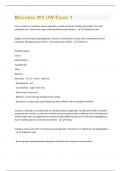
-
Microbio 301 UW Exam 1 Questions And Answers.
- Exam (elaborations) • 34 pages • 2024
- Available in package deal
-
- $11.49
- + learn more
Lack a nucleus or membrane bound organelles, usually unicellular. Smaller and simpler than most eukaryotic cells. Contain two types of domain Bacteria and Archaea. - Prokaryotic cells Ridged cell wall contains peptidoglycan. Includes a nucleoid (no nucleus) with no membrane-bound organelles. Multiply by binary fission - cell enlarges then divides - Bacteria Bacterial shapes: Coccus Rods (bacillus) Coccobacillus Vibrio Spirillum Spirochete - - Coccus - spherical - Rod (bacillus) - rod ...

Do you wonder why so many students wear nice clothes, have money to spare and enjoy tons of free time? Well, they sell on Stuvia! Imagine your study notes being downloaded a dozen times for $15 each. Every. Single. Day. Discover all about earning on Stuvia

